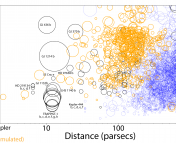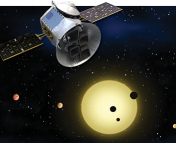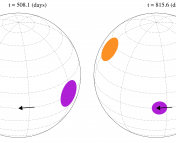Title: On the survivability of planets in young massive clusters
Authors: Maxwell X. Cai, S. Portegies, Zwart, M. B. N. Kouwenhoven, Rainer Spurzem
First Author’s Institution: Leiden Observatory, Leiden University, Leiden, The Netherlands
Status: submitted to MNRAS, open access on arXiv
It was just a few decades ago that humans had knowledge only of planets within our own solar system. Now, exoplanets are known to be quite widespread. Old missions like Kepler and current missions like TESS continue to contribute to our understanding of the qualities of exoplanets, but other questions remain. What sort of environments are conducive to planet formation and retention? In what locales may a sustained planetary system be unlikely or even impossible? Today’s paper considers an extreme location for a planetary system: Star clusters.
Among all 4000+ exoplanets discovered to date, fewer than 1% are found within star clusters. Only 30 exoplanets have been found within star clusters and a measly single planet has been detected within a dense globular cluster (GC). Why is this? Is there something about star clusters, and GCs in particular, that makes their environment uniquely inhospitable for planets to form? Or are our telescopes just missing them somehow? Today’s paper uses numerical simulations to study if the unique conditions within star groups that give rise to GCs, called young massive star clusters (YMCs), may influence the types of planets that can be retained within these gravitationally complex systems.
Creating solar systems in stellar systems
The authors run N-body simulations, codes that calculate the motions of large numbers of particles due to their mutual gravity, to study how different orbital characteristics affect the survivability of planetary systems in YMCs. Modeling planetary systems and YMCs with an N-body simulation introduces a few complications compared to simulating the evolution of large structures like galaxies. For example, the time scales on which objects are interacting in star clusters and planetary systems are much shorter than for larger structures, so it’s more memory intensive to store information about the interactions. The authors use special codes developed specifically to address these complications in modeling planetary systems.
The YMC star clusters are modeled with density profiles following a Plummer model and two types of planetary systems, called Models A and B, are placed randomly around solar-type stars within the cluster. Model A consists of 50 “massless” planets spanning average orbital distances from 6 AU to 400 AU and Model B contains 5 super-Earth type planets from 0.5 AU to 6 AU. They run 400 simulations in total, 200 of each model planetary system, for 100 million simulated years. The large number of simulations is necessary to accurately reflect the chaotic nature of planetary systems. A planet is declared to have “survived” if it still remains in orbit around its host star at the end of the 100 million years.
Natural selection in the YMC environment
In general, the more compact the planetary system, the better. Planets with larger average distances from their host stars are more likely to be ejected from their solar system. For planets with average orbital distances of 30 AU (the average distance of Neptune from the Sun) the odds of a planet surviving fall below 50% (Figure 1). Another significant factor is the local number density of stars. Regions with densely-packed stars have more opportunities for close encounters and enhanced gravitational influence between said stars and the poor, helpless little planets. However, their distance from the host star reigns supreme as the most significant parameter: The authors find that even in a densely populated stellar environment, planets with smaller average orbital distances are less likely to be ejected than those at greater distances in an underdense region (Figure 1). Further, in the first 40 million years of each simulation, planets are lost from their host systems at an extremely fast rate. As time goes on, however, the rate of loss seems to slow, becoming nearly flat.

Figure 1: Left: The surviving fraction (fsurv) of planets as a function of their average orbital distance, (a0). The orange line and equation in the upper right describe the best fit line describing the trend. Right: The ejection fraction (feject) of planets dependent on the local stellar number density (ρ) and the average orbital distance. Redder colors indicate a greater likelihood of being ejected, and the grey curve indicates the 50% ejection fraction. Figures 3 and 4 from the paper.
Oh, the places they’ll go
Rogue planets are a known phenomenon, and have been glimpsed wandering through the Galactic bulge (aka the center of the Milky Way). Are planets ejected from planetary systems within YMCs still flying about within the star cluster, or have they escaped and are off gallivanting through space? The authors determine that smaller average orbital distances (and thus higher orbital velocities) lead to higher ejection speeds. This is turn leads to higher chances of a planet escaping the YMC (Figure 2). Around 30% of all ejected planets escape the YMC immediately, although the remaining 70% of free-floating planets will also eventually free themselves of the YMC as the cluster begins to sort its constituents by mass. In a process called mass segregation, massive stars and star systems fall towards the center of the cluster while lightweight objects like small stars and rogue planets end up in the outskirts, where they can be ejected more easily.

Figure 2: Ratio of planet ejection velocity to the escape velocity of the YMC as a function of the average orbital distance at the time of ejection. Color indicates the initial average orbital distance of the planet, which can be modified throughout the simulation run time by gravitational interactions with the stars in the cluster. Figure 9 in the paper.
In conclusion, it appears that physically small planetary systems in star clusters are the most suitable to survive in such a gravitationally complex environment. From their results, the authors conclude that YMCs and GCs are likely to contain some small planetary systems, although unlikely to host many free-floating planets. They further speculate that the lack of detections of planets in star clusters is more impacted by the lack of heavy elements in YMCs, which is believed to inhibit the formation of Jovian planets.




